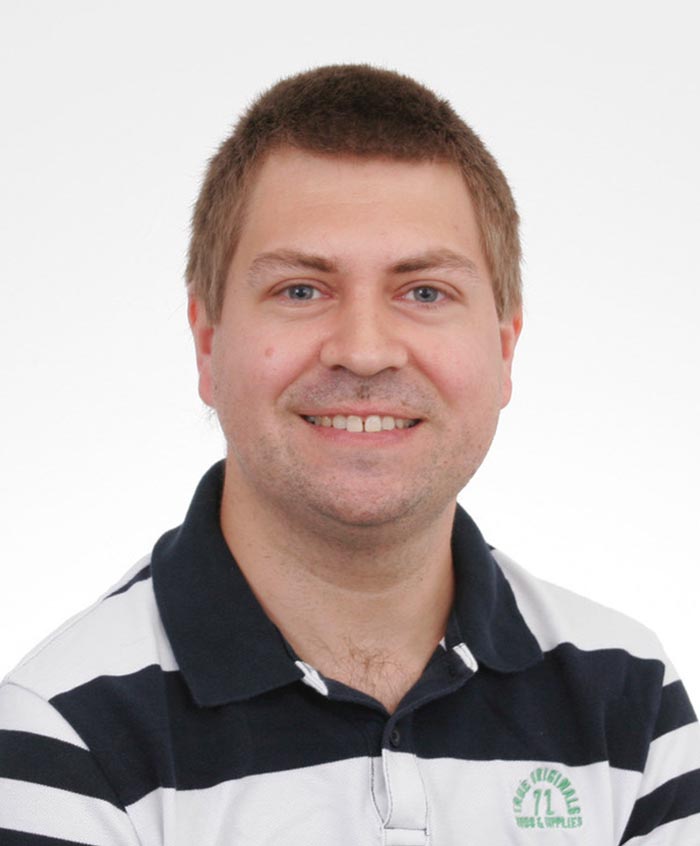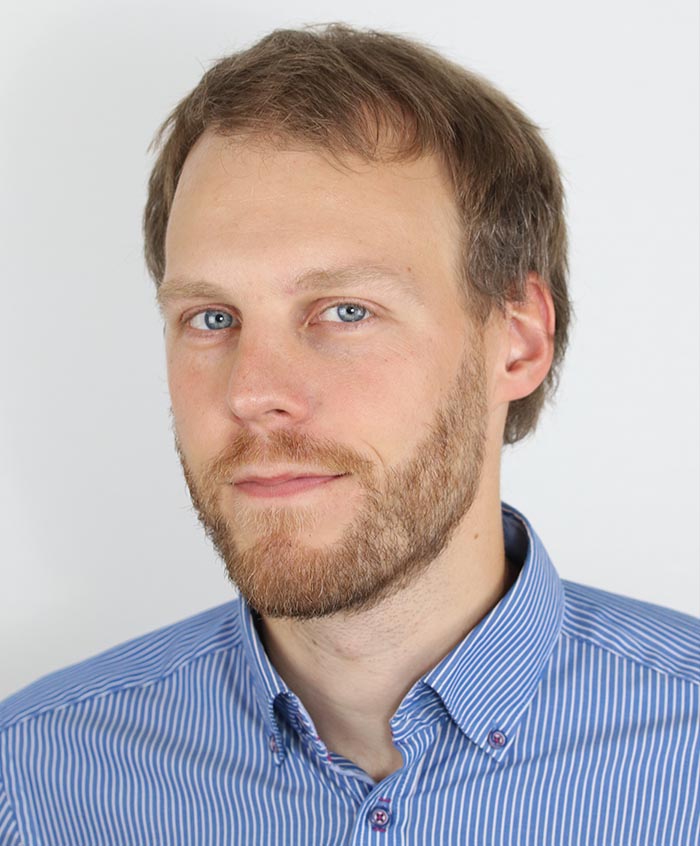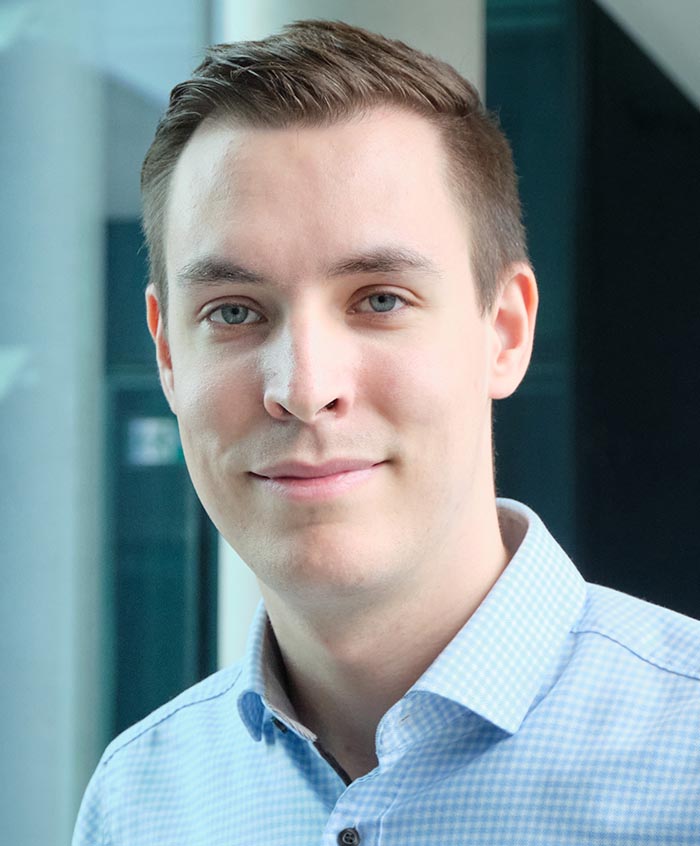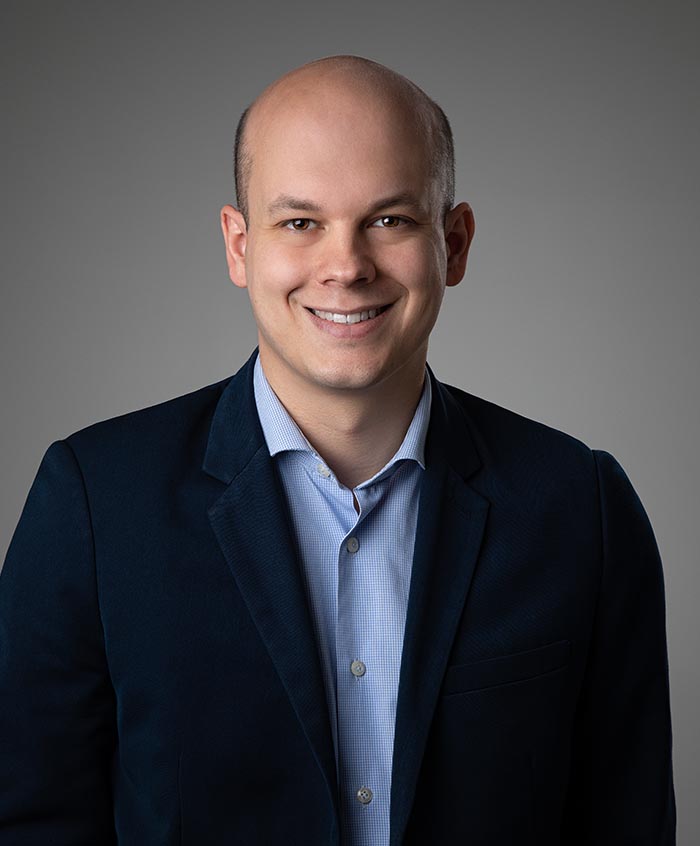
© Jasmin Schreiber
Dr. Lorenz Adlung
(Medicine)
University Medical Center Hamburg-Eppendorf
Center for Internal Medicine
“Cell therapy for healthy fatty tissue in old age”
With advancing age, the body undergoes changes – this also applies to the fatty tissue, which controls our metabolism and influences the immune system. Over the years, however, fatty tissue loses its ability to adapt. This can lead to chronic inflammation, which favors age-related conditions such as cardiovascular disease. Lorenz Adlung is investigating how immune cells known as lipid-associated macrophages (“LAM cells”), which he played a role in discovering, can influence this process. Initial findings suggest that LAM cells play a protective role. With modern high-throughput methods and computer-aided modeling, he is investigating whether a targeted therapy using LAM cells can maintain the health of fatty tissue in old age. In the long term, this research could identify new treatment options for counteracting age-related metabolic disorders – with the aim of enabling not only a longer, but also a healthier life.
Lorenz Adlung holds a doctorate in systems biology and is head of an independent junior research group at the University Medical Center Hamburg-Eppendorf. After earning his doctorate at the German Cancer Research Center in Heidelberg, he was a guest researcher at the Weizmann Institute in Israel. He has received several honors such as the Model of the Year Award of the European Bioinformatics Institute (EBI) and the Dr. Liselotte Brauns Research Prize for Internal Medicine. In addition to his interdisciplinary research, he is committed to science communication, for example as an award-winning science slammer, podcast co-host, and author.

© HZB Kevin Fuchs
Dr. Michelle Philippa Browne
(Chemistry)
Helmholtz-Center Berlin for Materials and Energy
Electrocatalysis young investigator group
“New Materials to Produce Green H2 from Anion Exchange Membrane Electrolysers”
To increase the percentage of green H2 produced by water splitting compared to the production of grey H2 by steam reformation, it is necessary to improve the efficiency associated with low temperature membrane water splitting technologies (e.g. Anion Exchange Membrane (AEM)). One way to improve the efficiency is to replace the current state-of the art catalysts with materials that are more active and stable which will result in a drastic paradigm shift in green H2 production. This project will focus on tailoring MXene and metal oxide catalyst layers to produce Green H2 in AEM devices.
Dr. Michelle Browne is currently the head of the Helmholtz Young Investigator Electrocatalysis: Synthesis to Device group at Helmholtz-Zentrum Berlin. She holds a Ph.D in Chemistry from Trinity College Dublin (Ireland). She has received prestigious fellowships and awards for her research, including, the Curious Minds Research Award, L’Oreal UNESCO Rising Talent UK & Ireland Fellowship, International Society of Electrochemistry (ISE) Elsevier Prize for Applied Electrochemistry award and the Clara Immerwahr Award from UniSysCat.

© Sebastian Frank
Dr. Sebastian Frank
(Psychology)
University of Regensburg
Institute of Psychology
“Mechanisms that promote visual learning and plasticity in children”
The human brain is formable and undergoes change throughout a person’s life as the result of experience and learning. This characteristic of the brain is referred to as plasticity. To date, brain plasticity has been studied above all in adults. On the other hand, little is known as to what plasticity mechanisms occur in children during learning, and how these mechanisms differ from those in adults. To close this gap in our understanding of learning and plasticity, in this project we intend to investigate visual learning among children of primary-school age and to determine why differences are encountered in visual learning between individual children.
Sebastian Frank studied psychology at the University of Regensburg, after which he earned his doctorate in cognitive neuroscience at Dartmouth College in the USA. He then worked as a postdoc at Brown University, likewise in the USA. Since 2022, he has headed an Emmy Noether Research Group at the Institute of Psychology at the University of Regensburg. His research interest focuses on the mechanisms of learning and of brain plasticity, and how these mechanisms change over the course of a person’s life.

© Kostas Margitudis
Dr. Michael Heide
(Biology)
German Primate Center
Brain Development and Evolution junior research group
“Cerebral organoids of the common marmoset: a potential alternative to animal experiments in brain research”
Research on common marmosets helps in our understanding of the development and evolution of the brain along with neurobiological diseases, but raises ethical issues. Cerebral organoids offer an alternative here, since they grow from stem cells and can replicate the development of the brain and, to a certain degree, its function. This project investigates the extent to which cerebral organoids of the common marmoset reflect the brain, what cell types develop, and what genes are active. The objective is to validate organoids as a model for studying development and evolution in the common marmoset, and to complement and reduce the need for animal experiments.
Michael Heide studied biology at the University of Tübingen and earned his doctorate at the University of Heidelberg; this was followed by a postdoc sojourn at the Max Planck Institute of Molecular Cell Biology and Genetics. Since 2022, as the recipient of an ERC Starting Grant he has headed a junior research group at the German Primate Center, where he is investigating the development and evolution of the cerebral cortex in primates.

© Katharina Haase
Dr. Stefanie Lenk
(Art History)
University of Göttingen
Art History Seminar and Arts Collection
“Trusting Images. How to Create Orthodox Imagery Amidst Heresy”
How should politics and the media deal with images created by artificial intelligence? The current spectrum ranges from calls for mandatory labeling to the misuse of such images for political purposes. The challenges we face in combating deepfakes to prevent a descent into post-truth politics are significant. As public distrust of governments and the media grows, the question of whether images can be trusted becomes increasingly urgent. My project provides a historical perspective on how medieval societies dealt with simultaneous crises of trust in institutions and images. Specifically, I examine how church authorities during the persecution of heretics in the 12th and 13th centuries sought to maintain the trustworthiness of religious images. The starting point of my project is the anti-heretical treatise De Altera Vita (c. 1235–36) by Lucas of Tuy.
Stefanie Lenk is a postdoctoral researcher and lecturer of Medieval Art History at the University of Göttingen. She previously earned her doctorate at the University of Oxford and worked as a curator at the British Museum as well as at the University of Bern. Her research interests include, in addition to late antique and medieval religious images aimed at lay audiences, university collections from the 19th and 20th centuries, as well as methods of collaborative and interdisciplinary research.

© privat
Dr. Markus Lüken
(Engineering Sciences)
RWTH Aachen
Chair of Medical Information Technology
“Monitoring blood pressure fluctuations with inconspicuous sensors”
Blood pressure fluctuations, and especially high blood pressure, can have serious effects on health but often remain undetected. In this project, an inconspicuous sensor system is being developed that is integrated into the patient’s bed for the continuous monitoring of blood pressure trends without the need for the usual cuff (sphygmomanometer). With this combination of multimodal, innovative, and inconspicuous measurement methods, parameters are extracted that enable conclusions to be drawn as to blood pressure development. The objective is to achieve trouble-free, patient-friendly monitoring of blood pressure trends in everyday clinical practice for optimal assessment of a patient’s condition.
Markus Lüken studied electrical engineering at RWTH Aachen University and earned his doctorate in 2021 with a study of the inconspicuous monitoring of gait stability in Parkinson’s patients. He is head of the “Biomedical Measurement Technology and Signal Processing” working group at the Institute for Medical Information Technology at RWTH Aachen University. His research focuses on non-invasive sensor systems and machine learning for medical diagnostics.

© Robert Mayer
Dr. Robert Mayer
(Chemistry)
TU Munich
Chair of Supramolecular Chemistry
“From molecules to life: Predicting key chemical reactions”
How life emerged from simple molecules is one of the great enigmas of chemistry. A decisive step towards a solving it involves incorporating phosphorus into biomolecules in the form of phosphate groups. However, without enzymes – the catalysts of life – these reactions take place slowly and are difficult to predict. This project sets out to analyze such reactions by means of machine learning, in order to better understand the chemical processes that took place on the young Earth.
Robert Mayer studied chemistry at LMU Munich, where he completed his doctorate in 2020. After a postdoc sojourn at the University of Strasbourg (France), he established a junior research group at TU Munich in 2024 that is currently funded by the Emmy Noether Program of the German Research Foundation (DFG). In his research, he combines physical-organic and computer-based approaches in order to investigate issues in organic chemistry that are relevant to catalysis research and to the origin of life.

© Björn Marquart
Jun.-Prof. Dr. Philipp Rothemund
(Engineering Science)
University of Stuttgart
Institute of Adaptive Mechanical Systems
“Physics of electrostatic artificial muscles”
Lifelike robots could improve our lives by working together with us, supporting us in our daily lives, and taking on hazardous tasks. To date, robots have mostly been made from hard materials such as metal and have been powered by motors. This makes them efficient but inflexible, and presents a hazard for humans. Artificial muscles that emulate those of humans could solve these problems, but are not sufficiently powerful. This project sets out to study the physics of electrostatic artificial muscles in detail. The resulting understanding will enable improved performance for a new generation of lifelike robots.
Philipp Rothemund studied mechanical engineering at ETH Zurich and earned his doctorate from Harvard University in 2018; he was a postdoc at the University of Colorado Boulder and at the Max Planck Institute for Intelligent Systems. He has been a tenure-track junior professor at the University of Stuttgart since 2023.

© Mr. Ergi Pinari PicaAI
Dr. Maria Villiou
(Chemistry)
MPI for Polymer Research
Physical Chemistry of Polymers working group
“Next-Generation Bioadhesives for Medicine”
Bioadhesives are revolutionizing medicine, playing a crucial role in wound closure, tissue engineering, and surgery. However, existing materials often struggle with mechanical stability, controlled degradation, and adaptability to modern manufacturing methods like 3D printing. This project develops next-generation bioadhesives that are biocompatible for safe medical use, photodegradable for precise light-controlled breakdown—enabling drug and cell release for faster healing and tissue regeneration—strongly adhesive for stable tissue attachment, and printable for patient-specific applications. The goal is to create smarter, more reliable, and personalized surgical adhesives that enhance medical treatments.
Since 2024, Maria has led the Biofabrication and Biomaterials Innovation (BIOFABLAB) research group at the Department of Physical Chemistry of Polymers at the Max Planck Institute for Polymer Research. She holds a BSc in Chemistry (2014, GR), a MSc in Biomedical Sciences (2016, GR), and a PhD in Biomaterials Synthesis and Bioengineering (2021, DE). She conducted postdoctoral research at several institutions at the University of Heidelberg (2020-2023). Her work is shaping the future of materials science and bioengineering.

© privat
Dr. Elena von Ohlen
(Literary Studies)
University of Duisburg-Essen
Institute of Romance Languages and Literatures
“The persecution of witches in the Iberian viceroyalties during the Inquisition: Autobiography and autofiction of indigenous and enslaved women”
This project focuses on the witch trials of the Inquisition tribunals in the Iberian viceroyalties. The biographies of the accused persons shed light on various different aspects of colonial society that were associated with sorcery and witchcraft in their pre-Hispanic and syncretic dimensions: Although they were protected against prosecution, indigenous and enslaved women were disproportionately often confronted with such indictments. The transcripts of the inquisition trials of the colonial tribunals, most of which are kept in the National Archives of Mexico, allow insights into the biographies of the persecuted women and facilitate an understanding of their testimonies as early examples of autobiographical and autofictional writing.
Elena von Ohlen is a researcher at the Institute of Romance Languages and Literatures at the University of Duisburg-Essen. She earned her doctorate at the Free University of Berlin in 2023 with a thesis on feminicide in law and literature in contemporary Latin American novels. Her research interests include the literatures of Latin America (16th–21st centuries), law and literature, and literary multilingualism.

© Susanne Kurz
Dr. Lisa Voskuhl
(Environmental Microbiology)
University of Duisburg-Essen
Faculty of Chemistry – Environmental Microbiology and Biotechnology
“Nature’s warriors – oil-degrading algal prokaryote communities of terrestrial and limnic mineral oil habitats”
We are all familiar with man-made oil disasters, such as the explosion of the Deepwater Horizon drilling rig or damaged oil tankers, in which millions of liters of oil are released into the environment. But did you know that oil has also been released into the natural environment without human intervention every day for thousands of years, and that nature has had time to adapt to these hostile conditions? The world’s largest natural source of oil is Pitch Lake in Trinidad and Tobago, and smaller natural oil wells of this kind also exist in Germany. By investigating algal isolates and their associated bacteria and archaea (= prokaryotes) from natural mineral oil habitats in Germany, this research project intends to improve our understanding of biological oil degradation by algal prokaryotic communities. The research focuses on their complex interactions, their composition, and measurement of their oil degradation rates; this will enable an evaluation of the potential of these communities for applications in environmental technology, especially in environmental protection.
Lisa Voskuhl is a junior research group leader at the University of Duisburg-Essen. She studied molecular life science and technical biochemistry and worked for several years in industry before completing her doctorate in Lübeck (2022). She has extensive national and international experience in industry and science.

© DPZ Karin Tilch
Dr. Erin Wessling
(Biology)
German Primate Center – Leibniz Institute for Primate Research
“Behavioral Innovations in Savanna Chimpanzees: Adaptations to a Challenging Ecosystem”
Research on the adaptability of savanna chimpanzees to challenging environments is crucial for understanding human evolution, as they inhabit regions similar to where key evolutionary transitions may have occurred. As our closest living relatives, research on their behavior their ecological adaptability and problem-solving skills, such as ranging patterns, resource exploitation, and tool use for accessing dynamic resources. By examining chimpanzee strategies for finding resources and avoiding the heat, we stand not only to deepen our understanding of chimpanzee ecology but also shed light on how early humans might have adapted to similar conditions.
Erin Wessling is a behavioral ecologist and biological anthropologist whose work focuses on using Pan species as model organisms to explore behavioral flexibility and adaptability across diverse environmental contexts. She completed her Ph.D. at the Max Planck Institute for Evolutionary Anthropology and held postdoctoral positions at Harvard University and the University of St. Andrews.
